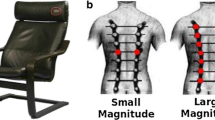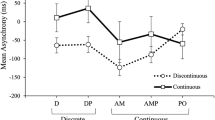Abstract
The ability to synchronise actions with environmental events is a fundamental skill supporting a variety of group activities. In such situations, multiple sensory cues are usually available for synchronisation, yet previous studies have suggested that auditory cues dominate those from other modalities. We examine the control of rhythmic action on the basis of auditory and haptic cues and show that performance is sensitive to both sources of information for synchronisation. Participants were required to tap the dominant hand index finger in synchrony with a metronome defined by periodic auditory tones, imposed movements of the non-dominant index finger, or both cues together. Synchronisation was least variable with the bimodal metronome as predicted by a maximum likelihood estimation (MLE) model. However, increases in timing variability of the auditory cue resulted in some departures from the MLE model. Our findings indicate the need for further investigation of the MLE account of the integration of multisensory signals in the temporal control of action.


Similar content being viewed by others
References
Alais D, Burr D (2004) The ventriloquist effect results from near-optimal bimodal integration. Curr Biol 14:257–262
Aschersleben G (2002) Temporal control of movements in sensorimotor synchronization. Brain Cogn 48:66–79
Aschersleben G, Bertelson P (2003) Temporal ventriloquism: crossmodal interaction on the time dimension. 2. Evidence from sensorimotor synchronization. Int J Psychophysiol 50:157–163
Doumas M, Wing AM (2007) Timing and trajectory in rhythm production. J Exp Psychol Hum Percept Perform 33:442–455
Elliott M, Welchman AE, Wing AM (2009) Being discrete helps keep to the beat. Exp Brain Res 192:731–737. doi:10.1007/s00221-008-1646-8
Ernst MO, Banks MS (2002) Humans integrate visual and haptic information in a statistically optimal fashion. Nature 415:429–433
Ernst MO, Bülthoff HH (2004) Merging the senses into a robust percept. Trends Cogn Sci 8:162–169
Kolers PA, Brewster JM (1985) Rhythms and responses. J Exp Psychol Hum Percept Perform 11:150–167
Maduell M, Wing AM (2007) The dynamics of ensemble: the case for flamenco. Psychol Music 35:591–627
Mamassian P (2008) Overconfidence in an objective anticipatory motor task. Psychol Sci 19:601–606
Oruc I, Maloney LT, Landy MS (2003) Weighted linear cue combination with possibly correlated error. Vision Res 43:2451–2468
Repp BH (2000) Compensation for subliminal timing perturbations in perceptual-motor synchronization. Psychol Res Psychol Forschung 63:106–128
Repp BH (2001) Phase correction, phase resetting, and phase shifts after subliminal timing perturbations in sensorimotor synchronization. J Exp Psychol Human Percept Perform 27:600–621
Repp BH, Penel A (2002) Auditory dominance in temporal processing: New evidence from synchronization with simultaneous visual and auditory sequences. J Exp Psychol Human Percept Perform 28:1085–1099
Ridderikhoff A, Peper CL, Beek PJ (2005) Unraveling interlimb interactions underlying bimanual coordination. J Neurophysiol 94:3112–3125
Semjen A, Summers JJ (2002) Timing goals in bimanual coordination. Q J Exp Psychol A 55:155–171
van Beers RJ, Sittig AC, Gon JJ (1999) Integration of proprioceptive and visual position-information: an experimentally supported model. J Neurophysiol 81:1355–1364
Vorberg D, Schulze HH (2002) Linear phase-correction in synchronization: predictions, parameter estimation, and simulations. J Math Psychol 46:56–87
Vorberg D, Wing A (1996) Modelling variability and dependence in timing. In: Keele S, Heuer H (eds) Handbook of perception and action. Academic Press, New York, pp 181–262
Wing AM (1980) The long and short of timing. In: Stelmach GE, Requin J (eds) Tutorials in motor behavior. North Holland Publishing, Amsterdam
Wing AM (2002) Voluntary timing and brain function: an information processing approach. Brain Cogn 48:7–30
Wing AM, Kristofferson AB (1973) Response delays and timing of discrete motor responses. Percept Psychophys 14:5–12
Wing AM, Woodburn C (1995) The coordination and consistency of rowers in a racing eight. J Sports Sci 13:187–197
Acknowledgments
This work was supported by the Medical Research Council (grant no. G9901257) and the Biotechnology and Biological Sciences Research Council (grant nos C520620 and E0095651). MD is a postdoctoral fellow of the Fund for Scientific Research (FWO) Flanders. We thank Nick Roach for assistance in setting up the haptic stimulus apparatus.
Author information
Authors and Affiliations
Corresponding author
Rights and permissions
About this article
Cite this article
Wing, A.M., Doumas, M. & Welchman, A.E. Combining multisensory temporal information for movement synchronisation. Exp Brain Res 200, 277–282 (2010). https://doi.org/10.1007/s00221-009-2134-5
Received:
Accepted:
Published:
Issue Date:
DOI: https://doi.org/10.1007/s00221-009-2134-5




